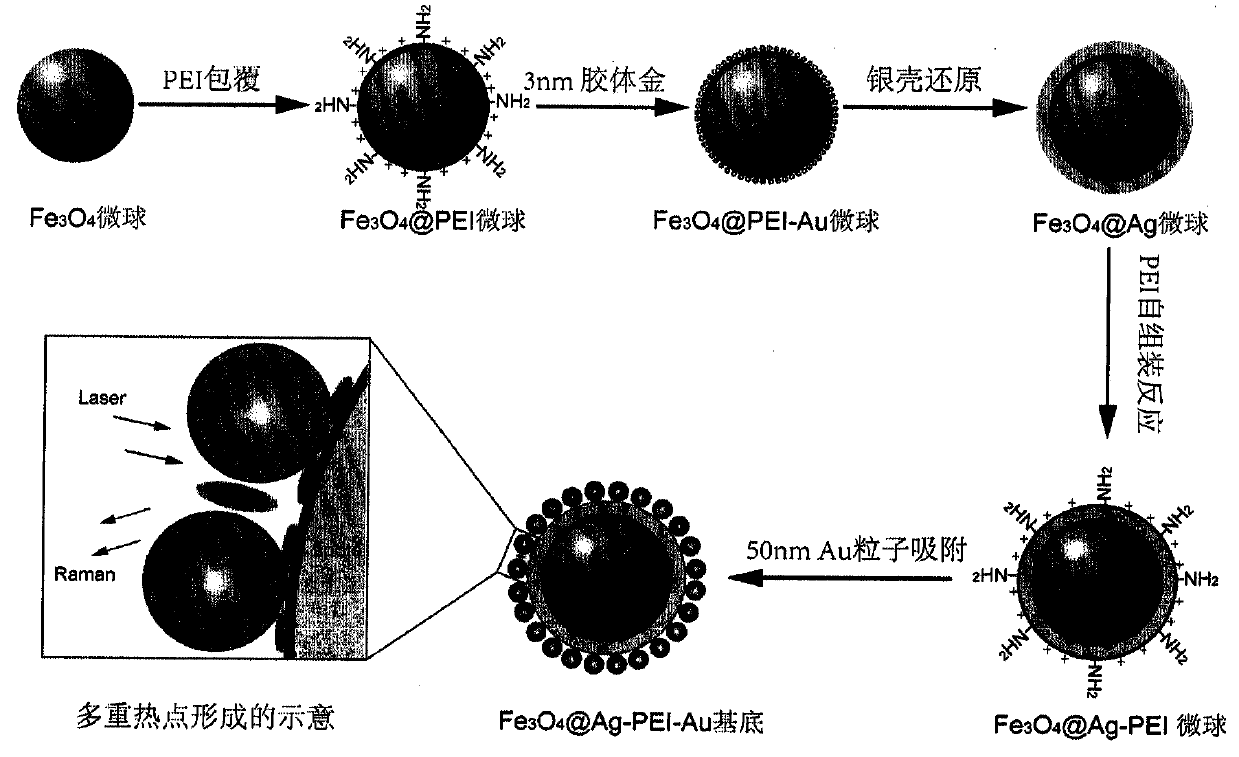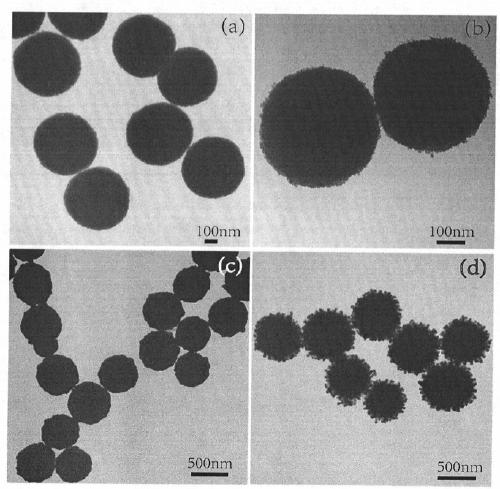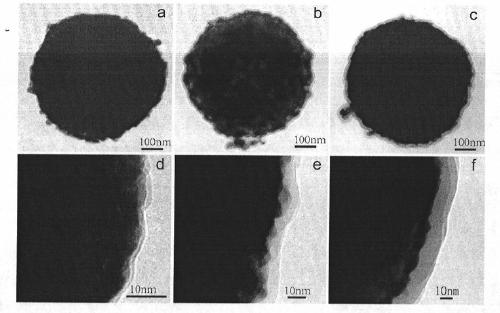A magnetic composite SERS substrate with a core-shell-satellite three-dimensional structure and its preparation method
A three-dimensional structure, magnetic composite microsphere technology, applied in the field of nanomaterials, biochemical spectral analysis and detection, can solve the problems of weak magnetic response, poor dispersion, poor SERS performance, etc., achieve strong sensitivity, low cost, and huge application potential Effect
- Summary
- Abstract
- Description
- Claims
- Application Information
AI Technical Summary
Problems solved by technology
Method used
Image
Examples
Embodiment 1
[0044] Preparation of a core-shell-satellite three-dimensional structure magnetic surface Raman-enhanced microspheres
[0045] figure 1 A schematic diagram of the preparation process of the core-shell-satellite three-dimensional magnetic surface Raman-enhanced microspheres is given. Its specific preparation method is divided into the following six steps: the first step, using solvothermal synthesis method to synthesize 400nm Fe 3 o 4 Microspheres. Dissolve 2.7 g of ferric chloride hexahydrate in 80 ml of ethylene glycol, and stir magnetically for 30 minutes. Next, 5.4 g of sodium acetate and 2 g of polyethylene glycol 6000 were added to the solution and stirred until the reactants were completely dissolved, then the mixture was transferred to an autoclave (100 ml capacity) with a polytetrafluoroethylene liner and heated to 200 °C for 10 hours. The product was collected with a magnet, washed three times with deionized water and ethanol respectively, and finally the product...
Embodiment 2
[0055] SERS characterization to detect whether the gap formed by polymer PEI is a loose and porous structure capable of accommodating small molecules:
[0056] Synthesized Fe with PEI self-loading layer thicknesses of 1.5nm, 8nm, 18nm 3 o 4 @Ag-PEI microspheres with unmodified Fe 3 o 4 @Ag for contrast. PATP was selected as the Raman molecule. PATP is a commonly used sulfhydryl Raman marker, and it will produce significant chemically enhanced Raman characteristic peaks when combined with gold or silver. Add the four synthetic particles to 1ml with a concentration of 10 -6 Mix and shake in the PATP solution of M for 30 minutes. After magnetic separation, disperse the particle concentrate on a clean silicon wafer, and perform Raman detection after drying.
[0057] Figure 5 It is the experimental result of Example 2. exist Figure 5 The middle abscissa is the Raman shift. Figure 5 The middle curves a, b, c and d represent the PEI self-loading layer thickness of 1.5nm,...
Embodiment 3
[0059] Improve the SERS activity of silver-shell magnetic beads by modifying the surface with satellite-structured gold nanoparticles:
[0060] The SERS activity of the core-shell-satellite three-dimensional structure magnetic SERS substrate modified with 50nm and 25nm gold nanoparticles on the surface was compared with that of unmodified silver-shell magnetic beads. Figure 6 It is the experimental result of embodiment 3. exist Figure 6 Among them, curves b and c respectively represent 25nm gold particles and 50nm gold particles modified core-shell-satellite three-dimensional structure SERS microspheres to detect PATP (10 -11 The characteristic peak of M), curve a represents that common silver-shell magnetic beads detect PATP (10 -9 M) characteristic peaks. This result shows that the detection sensitivity of 25nm gold nanoparticles modified core-shell-satellite three-dimensional structure magnetic SERS microspheres for detecting PATP is 3 orders of magnitude higher than t...
PUM
| Property | Measurement | Unit |
|---|---|---|
| thickness | aaaaa | aaaaa |
| thickness | aaaaa | aaaaa |
Abstract
Description
Claims
Application Information
 Login to View More
Login to View More - R&D
- Intellectual Property
- Life Sciences
- Materials
- Tech Scout
- Unparalleled Data Quality
- Higher Quality Content
- 60% Fewer Hallucinations
Browse by: Latest US Patents, China's latest patents, Technical Efficacy Thesaurus, Application Domain, Technology Topic, Popular Technical Reports.
© 2025 PatSnap. All rights reserved.Legal|Privacy policy|Modern Slavery Act Transparency Statement|Sitemap|About US| Contact US: help@patsnap.com



